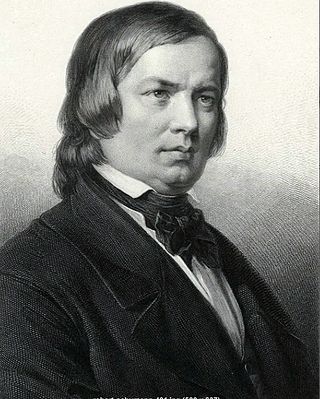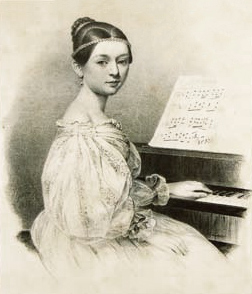
Robert Schumann was a German composer, pianist, and influential music critic. He is widely regarded as one of the greatest composers of the Romantic era. Schumann left the study of law, intending to pursue a career as a virtuoso pianist. His teacher, Friedrich Wieck, a German pianist, had assured him that he could become the finest pianist in Europe, but a hand injury ended this dream. Schumann then focused his musical energies on composing.

The Piano Concerto in A minor, Op. 54, by the German Romantic composer Robert Schumann was completed in 1845 and is the composer's only piano concerto. The complete work was premiered in Dresden on 4 December 1845. It is one of the most widely performed and recorded piano concertos from the Romantic period.

Carnaval, Op. 9, is a work by Robert Schumann for piano solo, written in 1834–1835 and subtitled Scènes mignonnes sur quatre notes. It consists of 21 short pieces representing masked revelers at Carnival, a festival before Lent. Schumann gives musical expression to himself, his friends and colleagues, and characters from improvised Italian comedy. He dedicated the work to the violinist Karol Lipiński.

Robert Schumann's Fantasiestücke, Op. 12, is a set of eight pieces for piano, written in 1837. The title was inspired by the 1814–15 collection of novellas, essays, treatises, letters, and writings about music, Fantasiestücke in Callots Manier by one of his favourite authors, E. T. A. Hoffmann. Schumann dedicated the pieces to Fräulein Anna Robena Laidlaw, an accomplished 18-year-old Scottish pianist with whom Schumann had become good friends.

Kreisleriana, Op. 16, is a composition in eight movements by Robert Schumann for solo piano, subtitled Phantasien für das Pianoforte. Schumann claimed to have written it in only four days in April 1838 and a revised version appeared in 1850. The work was dedicated to Frédéric Chopin, but when a copy was sent to the Polish composer, "he commented favorably only on the design of the title page".

Woldemar Bargiel was a German composer and conductor of the Romantic period.
The Piano Trio No. 3 in G minor by Robert Schumann was written in 1851, and is his opus 110. It has four movements:
- Bewegt, doch nicht zu rasch in G minor, in 6
8 time. In sonata form. - Ziemlich langsam in E-flat major, in 12
8 time and tempo 116 eighth notes to the minute. - Rasch in C minor, in 2
4 time and 138 quarter notes to the minute. A scherzo with two trios, with a tempo marking of Etwas zurückhaltend bis zm langsameren Tempo leading into the first trio, in C major with an upward chromatic theme, and a second trio in A-flat major which is more markedly rhythmic and diatonic in character. - Kräftig, mit Humor in G major, in common time and 104 quarter notes to the minute. There is a prominent episode in this rondo which quotes the C major trio from the scherzo.

The Symphonic Studies, Op. 13, is a set of études for solo piano by Robert Schumann. It began in 1834 as a theme and sixteen variations on a theme by Baron von Fricken, plus a further variation on an entirely different theme by Heinrich Marschner.

The Piano Sonata No. 28 in A major, Op. 101, by Ludwig van Beethoven was composed in 1816 and published in 1817. Dedicated to the pianist Baroness Dorothea Ertmann, née Graumen, it is considered the first of the composer's late piano sonatas.
The Davidsbündler was a music society created by Robert Schumann in his writings. It was inspired by literary societies, real and imagined ones, such as the Serapionsbrüder of ETA Hoffmann. The group was created to defend the cause of contemporary music against its detractors. Its two main members were supposed to be named Florestan and Eusebius, respectively symbolising the extroverted and introspective sides of his personality.

Great Pianists of the 20th Century – Martha Argerich II is the third volume of the Great Pianists of the 20th Century box set and is the second of two volumes dedicated to her. The album features music by the composers Frédéric Chopin, Franz Liszt, and Robert Schumann. The works were recorded between 1960 and 1975.
Blumenstück in D-flat, Op. 19, is a piano work by Robert Schumann, written in 1839. Blumenstück is a series of short, connected and thematically related episodes, of which the second forms a recurring refrain while undergoing changes in both key and mood. It is considered to reflect the amorous human activities with which flowers are associated, rather than as depictions of flowers themselves. The piece takes between six and seven minutes to play.

The Novelletten, Op. 21, is a set of eight pieces for solo piano, written by Robert Schumann in 1838. This composition is dedicated to Adolf von Henselt.
Robert Schumann wrote his Arabeske in C major, Op. 18 in 1839 when he was 29 years old, dedicating it to Frau Majorin Friederike Serre auf Maxen, to whom he also dedicated his Blumenstück in D-flat, Op. 19. In the autumn of 1838 Schumann had left Leipzig for Vienna. His relationship with Clara Wieck had reached a point of no return, as her father vehemently opposed anything that might interfere with his daughter's career as a pianist and strongly disapproved of Schumann as a possible son-in-law. Geographically yet not emotionally detached from Clara, he was able to communicate with her only through letters and in his own music. This has been proposed as an explanation for this work, which alternates passages of wistful longing with more robust, declamatory episodes.
The Piano Sonata No. 2 in G minor, Op. 22 was composed by Robert Schumann from 1830 to 1838.
Märchenerzählungen, Op. 132, is a trio composition by Robert Schumann in four movements for clarinet, viola and piano. He composed the clarinet-viola-piano trio in B-flat major, between 9 and 11 October 1853. The movements are connected by a motif (Kernmotiv). The work is dedicated to Schumann's pupil Albert Dietrich, and was published in 1854 by Breitkopf & Härtel.

The Piano Concerto in A minor, Op. 7, was composed by Clara Wieck, better known as Clara Schumann after her later marriage to Robert Schumann. She completed her only finished piano concerto in 1835, and played it first that year with the Leipzig Gewandhaus Orchestra, conducted by Felix Mendelssohn.

Three Fantasiestücke for piano, Op. 111, were written in 1851 by Robert Schumann.










